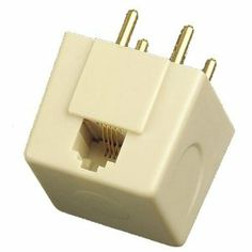Hey FCC: #theboxainttheproblem
NEW YORK—You would need a crystal ball to see what the FCC has in mind with its recent 3-2 vote to proceed with the chairman’s #unlockthebox proposal. Certainly the words in this proposal have just the right feel-good tone, with lots of focus on consumer choice and promoting innovation. We’re all consumers, after all. Who doesn’t want to think that someone in Washington is going to bat for the little guy?

RJ-11 (photo credit: ecx.images-amazon.com)
But when the cable networks argue that the FCC is looking backwards, I find it hard not to agree. Let’s start by examining the Chairman’s faulty comparison between today’s cable service and the old days of telephone service. The transition to store bought, third-party telephones that was facilitated when the FCC mandated support for third party devices was beneficial to consumers and their wallets, but the phone companies were left with the wire to your house and no control over anything past that point. That moment was the effective end of innovation on the telephone network--and who could blame the phone companies? In the name of standardization the FCC (to a large extent following court rulings) put a stake in the ground in 1976 and Ma Bell never progressed beyond voice-only solutions.
Well, there was one notable beneficial exception. The FCC chose the lowly RJ-11 as the “registered jack” point of demarcation. This simple device that permitted consumers to plug any device into the network paved the way for the plug-in, store-bought, computer modem to replace the acoustically coupled ones being used up to that time. This innovation undoubtedly helped lead to AOL and widespread use of the Internet. Of course, that glory has long been supplanted by the cable modem. More on that later.
With its position on set top boxes, the FCC is again driving a stake in the ground that may foster short-term innovation and lower rental fees, but the obsolescence of that stake is already written on the wall.
The FCC is specifying a magic box, a complicated spin on the RJ-11 type of universal interconnect. The objective is for this box to connect to the cable company’s video-over-QAM network and convert the output to IP. Maybe this would even be built into the cable modem. The theory is that this would permit new, innovative, store-bought devices to plug into this adapter while permitting, in fact encouraging, the cable companies to keep their old networks unchanged. Long live QAM!
The misstep here is that unlike the old telephone company, the business of cable providers is not built around their wire. It’s the interface on the STB that is their storefront; a portal the cable companies have created through which they directly engage the consumer and upsell VOD and other services. By demanding that these systems support third party boxes, the Chairman is expecting the cable companies to let go of the consumer experience upon which for better or worse they have built their businesses. No wonder the cable companies object!
The professional video industry's #1 source for news, trends and product and tech information. Sign up below.
Practically speaking, by the time the standards under discussion are firmed up and pass the inevitable lawsuits that will be thrown in their path, they will be obsolete. They are halfway there already.
This is not to suggest that the FCC doesn’t have a role in helping consumers by improving the quality of their experience. It’s just that the solution being offered is too late and too small. The FCC only sees two objectives: the political challenge to encourage more competition in the MVPD space, and the technical challenge to drive innovation in the consumer experience.
By focusing on the STB, the FCC is taking a pass on the obvious, bigger need for more competition in the broadband space. Real progress and lasting innovation in the telephone industry didn’t spring from the RJ-11 connector. What the FCC eventually got right was another 20 years down the road when legislation forced the Baby Bells to open their networks to competitors. When competitors gained access to the networks we saw meaningful, new technologies like SIP and VOIP that presented customers with choice.
Likewise, the new universal adapter being proposed will not be the thing people fondly look back on. The FCC should be maneuvering for real broadband choice for consumers. Most U.S. consumers have one or at best two choices for broadband. Their broadband provider holds all the cards. That needs to change if there is to be meaningful competition. In Europe, governments require that companies that own pipes lease space in their pipes to rival companies. In the U.S. the places with the best service exist where the cities and towns own the pipes and lease them to third parties. If we have true competition in how the IP signal gets to the consumer, the MVPDs will be forced to innovate and TV over QAM will fade away.
That doesn’t mean the cable industry is out of options. Current IP hardware is light years beyond the cable box at a fraction of the cost of renting an STB. Heck, my 10-year-old TiVo exceeds anything I’ve seen in a cable STB. But MVPDs are getting smarter. They know their video services are at risk and that fact is driving innovation such as Charter and Time Warner’s recent adoption of Roku as an IP STB.
We should applaud the FCC for taking some action, but at the same time realize that we don’t have another 20 years to fix the real problem. At the end of the day, if the FCC is serious it needs to focus on bigger issues. Making broadband, not STBs, more competitive will create a landscape with real consumer choice. Make that happen and the closed MVPD delivery system will die of natural causes and drive innovation as MVPDs innovate to survive.
